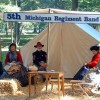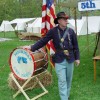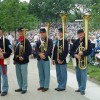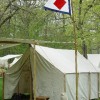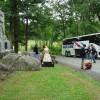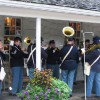
Saxhorns
“The style of brass instrument most often associated with Civil War bands was the over-the-shoulder Saxhorn, or OTS Saxhorn for short. Its distinguishing characteristic was the direction of the bell, which was pointed to the rear to direct the sound of the music to the troops marching behind the band.”
“… in the early 1840’s, a complete family (soprano to bass) of homogeneous valved bugles or saxhorns was created. Saxhorns were named after their creator, Adolphe Sax, the well-known Franco-Belgian instrument maker and inventor (who developed saxophones, a family of woodwind instruments).
“Saxhorns have fairly large bores (relative to their length) which expand rapidly in the last section; the bells flare only moderately. Because the tube bore of saxhorns are predominantly conical, the instruments produce a soft mellow sound that blends well together. They have sufficient carrying power to be heard out of doors. Their intonation, while not perfect, is relatively accurate. The instruments are comparatively easy to play. The combination of these qualities made saxhorns very popular.”
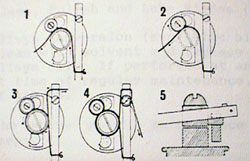 “Civil War valved instruments can be classified into four general categories which are determined by the direction of the bell and the shape of the instrument. They are bell front, upright, circular, and over the shoulder. In addition to the four shapes, the instruments can be subclassified according to the type of valve mechanism used. The two most common valve types were the American string linkage rotary valve (top or side action) and the durable Berliner piston valve.”
“Civil War valved instruments can be classified into four general categories which are determined by the direction of the bell and the shape of the instrument. They are bell front, upright, circular, and over the shoulder. In addition to the four shapes, the instruments can be subclassified according to the type of valve mechanism used. The two most common valve types were the American string linkage rotary valve (top or side action) and the durable Berliner piston valve.”
Excerpts from, A Pictorial History of Civil War Era Musical Instruments & Military Bands.
Rope-Tensioned Drums
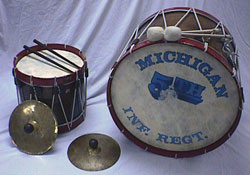 “The typical drum section of a Civil War brass band consisted of three instruments – rope tension snare (side) drum, bass drum, and a pair of cymbals. A few large bands of the period used more than one snare drum, but that was atypical. “The design and construction of nineteenth century rope tension drums were based on established patterns and methods of drum making that were more than three centuries old. In general, a cylinder-shaped wooden shell was used, with ‘heads’ made of animal skin stretched over the open ends.” Excerpts from, A Pictorial History of Civil War Era Musical Instruments & Military Bands.
“The typical drum section of a Civil War brass band consisted of three instruments – rope tension snare (side) drum, bass drum, and a pair of cymbals. A few large bands of the period used more than one snare drum, but that was atypical. “The design and construction of nineteenth century rope tension drums were based on established patterns and methods of drum making that were more than three centuries old. In general, a cylinder-shaped wooden shell was used, with ‘heads’ made of animal skin stretched over the open ends.” Excerpts from, A Pictorial History of Civil War Era Musical Instruments & Military Bands.
